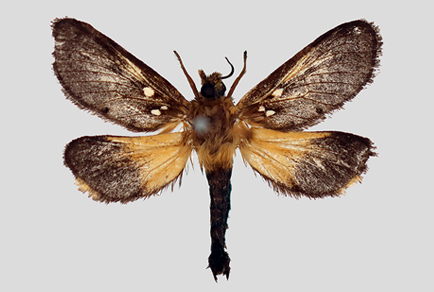Abstract
Two new species of the genus Palpifer Hampson, 1893 are described. The first species, named P. qinglai sp. nov. from Yunnan University in Kunming, Yunnan, China, is similar to P. sexnotatus (Moore, 1879) but distinguished by differences in forewing pattern, male genitalia structure and DNA barcode sequence. The second species, named P. bazi sp. nov. from Mengzi, Honghe, Yunnan, China, resembles P. boonei Grehan & Mielke, 2019 but also differs in the same characteristics.
References
- Bertheau, C., Schuler, H., Krumboeck, S., Arthofer, W. & Stauffer, C. (2011) Hit or miss in phylogeographic analyses: the case of the cryptic NUMTs. Molecular Ecology Resources, 11, 1056–1059. https://doi.org/10.1111/j.1755-0998.2011.03050.x
- Grehan, J.R. & Ismavel, V.A. (2017) Forest ghost moth fauna of northeastern India (Lepidoptera: Hepialidae: Endoclita, Palpifer, and Hepialiscus). Journal of Threatened Taxa, 9, 9940–9955. https://doi.org/10.11609/jott.3030.9.3.9940-9955
- Grehan, J.R. & Mielke, C.G.C. (2019) Two new species of Palpifer Hampson, 1893 from South East Asia (Lepidoptera: Hepialidae). Bishop Museum Occasional Papers, 125, 1–23.
- Grehan, J.R., Mielke, C.G.C., Minet, J., Ignatev, N., Buchsbaum, U. & Xue, D. (2021) Taxonomic composition and monophyly of the genus Magnificus (Lepidoptera: Hepialoidea: Hepialidae). Zootaxa, 4920 (3), 339–358. https://doi.org/10.11646/zootaxa.4920.3.2
- Hall, T.A. (1999) BioEdit: a user-friendly biological sequence alignment editor and analysis program for Windows 95/98/NT. In: Nucleic acids symposium series. IRL Press, Oxford University, Oxford, pp. 95–98.
- Hampson, G.E. (1893) The Fauna of British India, including Ceylon and Burma. Moths. VoI. I. Taylor & Francis, London, xxxvii + 438 pp.
- Hu, S.-J., Cotton, A., Condamine, F., Duan, K., Wang, R.-J., Hsu, Y.-F., Zhang, X. & Cao, J. (2018) Revision of Pazala Moore, 1888: the Graphium (Pazala) mandarinus (Oberthür, 1879) group, with treatments of known taxa and descriptions of new species and new subspecies (Lepidoptera: Papilionidae). Zootaxa, 4441 (3), 401–446. https://doi.org/10.11646/zootaxa.4441.3.1
- Ignatev, N., Grehan, J.R., Mielke, C.G.C., Shih, L.-C. & Mueller, G.C. (2023) Three new Chinese species of Palpifer Hampson from the collection of Franz Daniel (Lepidoptera: Hepialidae). Zootaxa, 5284 (2), 322–336. https://doi.org/10.11646/zootaxa.5284.2.5
- Karim, S.A. & Grehan, J.R. (2019) First records of the ghost moth genus Palpifer Hampson, [1893] (Lepidoptera: Hepialidae) from the Indian subcontinent south of the Himalaya. Journal of Threatened Taxa, 11, 14777–14779. https://doi.org/10.11609/jott.4955.11.13.14777-14779
- Kimura, M. (1980) A simple method for estimating evolutionary rates of base substitutions through comparative studies of nucleotide sequences. Journal of molecular evolution, 16, 111–120. https://doi.org/10.1007/BF01731581
- Kumar, S., Stecher, G. & Mega, K.T. (2016) Molecular evolutionary genetics analysis version 7.0 for bigger datasets. Molecular Biology and Evolution, 33 (7), 1870–1874. https://doi.org/10.1093/molbev/msw054
- Mielke, C.G.C. & Casagrande, M.M. (2013) A new Cibyra Walker, 1856 from southern Brazil (Lepidoptera, Hepialidae). Nachrichten des Entomologischen Vereins Apollo, N.F., 34 (1/2), 73–86.
- Moore, F. (1879) 2. Descriptions of new Genera and Species of Asiatic Lepidoptera Heterocera. In: Proceedings of the Zoological Society of London. Wiley Online Library, Hoboken, New Jersey, pp. 387–417. https://doi.org/10.1111/j.1096-3642.1879.tb02671.x
- Song, H., Buhay, J.E., Whiting, M.F. & Crandall, K.A. (2008) Many species in one: DNA barcoding overestimates the number of species when nuclear mitochondrial pseudogenes are coamplified. Proceedings of the national academy of sciences, 105, 13486–13491. https://doi.org/10.1073/pnas.0803076105
- Thompson, J.D., Higgins, D.G. & Gibson, T.J. (1994) CLUSTAL W: improving the sensitivity of progressive multiple sequence alignment through sequence weighting, position-specific gap penalties and weight matrix choice. Nucleic acids research, 22, 4673–4680. https://doi.org/10.1093/nar/22.22.4673
- Tindale, N.B. (1942) Revision of the ghost moths (Lepidoptera Homoneura, family Hepialidae). Part V. Records of the South Australian Museum, 7, 151–168.
- Xu, Z.-B., Wang, Y.-Y., Condamine, F.L., Cotton, A.M. & Hu, S.-J. (2020) Are the yellow and red marked club-tail Losaria coon the same species? Insects, 11 (392), 1–23. https://doi.org/10.3390/insects11060392


